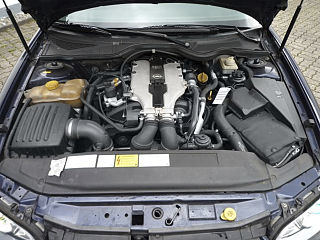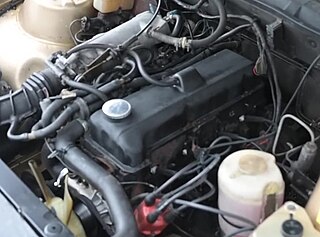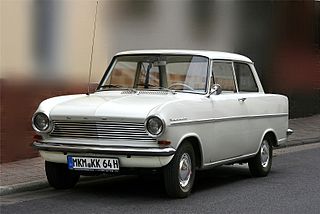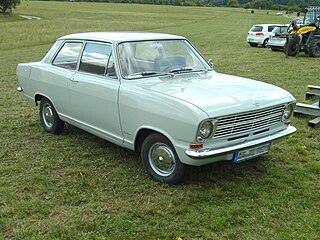
Vauxhall Motors Limited is a British car company headquartered in Chalton, Bedfordshire, England. Vauxhall became a subsidiary of Stellantis in January 2021.

The Vauxhall Chevette is a supermini car that was manufactured by Vauxhall in the United Kingdom from 1975 to 1984. It was Vauxhall's version of the "T-Car" small-car family from Vauxhall's parent General Motors (GM), and based primarily on the Opel Kadett C. The family also included the Isuzu Gemini in Japan, the Holden Gemini in Australia, the Chevrolet Chevette in the United States, Canada, Brazil, Colombia, Ecuador and Argentina, and in the U.S. and Canada it was also rebadged as the Pontiac Acadian/Pontiac T1000.

The Vauxhall Astra is a compact car/small family car (C-segment) that has been sold by Vauxhall since 1980. Over its eight generations, it has been made at several GM/Opel/Stellantis plants around Europe - however most versions have been sourced from Vauxhall's plant at Ellesmere Port, Cheshire, England.

The Vauxhall Cavalier is a large family car that was sold primarily in the United Kingdom by Vauxhall from 1975 to 1995. It was based on a succession of Opel designs throughout its production life, during which it was built in three incarnations. The first generation of Cavalier, launched in 1975 and produced until 1981, was Vauxhall's version of the General Motors 'U-Car' - essentially an Opel Ascona B/ Opel Manta with a few minor visual differences.

The Opel Kadett is a small family car produced by the German automobile manufacturer Opel from 1936 until 1940 and then from 1962 until 1991, when it was succeeded by the Opel Astra.

The Opel Ascona is a large family car that was produced by the German automaker Opel from 1970 to 1988. It was produced in three separate generations, beginning with rear-wheel-drive and ending up as a front-wheel drive J-car derivative. The Ascona was developed to fill the gap in the Opel range as the Opel Rekord was gradually growing in size.

The BMW M10 is a SOHC inline-4 petrol engine which was produced by BMW from 1962-1988. It was the company's first four-cylinder engine since the BMW 309 ended production in 1936 and was introduced in the New Class sedans.
After an early flirtation with V-twin engines, Mazda's small cars of the 1960s were powered by OHV straight-2 and straight-4 engines. This family lasted from 1961 until the mid-1970s. Today, Mazda's keicars use Suzuki engines. It was produced at the Hiroshima Plant in Hiroshima, Japan.

General Motors' Opel subsidiary in Europe designed a compact V6 engine with an unusual 54° vee angle. It was an iron block/aluminum head DOHC design with four valves per cylinder. All 54° engines were assembled at Ellesmere Port in England.
The Nissan H series of automobile engines is an evolution of the Nissan "R" engine which was based on the 1.5-liter, three-main bearing "G" engine used in the 1960s. Both inline-four and inline-six versions were produced. It is a pushrod OHV design with iron block, early models with an iron head, later models with aluminum head. Versions of this motor have been used in many Nissan autos and forklifts, well into the eighties and a version called H20II was in production until 2003. The SD diesels are based on this series of motors

The Prince G-series engine was the company's only straight-four and straight-six engines which began production in 1955. A number of variations were made, with both OHV and OHC heads. A diesel four-cylinder with 1.9 L (1,862 cc) was also built, called the D-6. The G series was used in the Skyline, the Laurel, and the Gloria from the 1950s to the early 1970s.

The GM Family I is a straight-four piston engine that was developed by Opel, a former subsidiary of General Motors and now a subsidiary of PSA Group, to replace the Vauxhall OHV, Opel OHV and the smaller capacity Opel CIH engines for use on small to mid-range cars from Opel/Vauxhall. The engine first appeared in the Opel Kadett D in 1979, and shortly afterwards in its Vauxhall badged sister – the Vauxhall Astra Mk.1 in 1980. Despite this, the previous Opel OHV engine continued to be sold in entry level versions of the Opel Kadett/Astra and Corsa throughout the 1980s.

The Opel Manta is a rear-wheel-drive sports coupé built by German manufacturer Opel in two generations from 1970 to 1988. The Manta was a mildly sporting coupé based on the Ascona family car, competing with cars such as the Ford Capri. The Manta remained rear-wheel drive for both generations and also saw certain competition success. Its name comes from the manta ray.

The Family II is a straight-4 piston engine that was originally developed by Opel in the 1970s, debuting in 1981. Available in a wide range of cubic capacities ranging from 1598 to 2405 cc, it simultaneously replaced the Opel CIH and Vauxhall Slant-4 engines, and was GM Europe's core mid-sized powerplant design for much of the 1980s, and provided the basis for the later Ecotec series of engines in the 1990s.

The Opel Kadett C is a small family car which was produced by the German automobile manufacturer Opel from 1973 to 1979. The Kadett C, which was the fourth generation of the Opel Kadett, was released in August 1973, and was Opel's version of the General Motors "T-Car". It was the last small Opel to feature rear-wheel drive, and remained in production at Opel's Bochum plant until July 1979, by which time Opel had produced 1,701,076. Of these, 52% had been exported outside West Germany, most of them to markets in other parts of western Europe. In other world markets, however, various badge engineered versions of the Kadett C remained in production as late as the mid-1990s under other GM brand names.

The Opel Corsa is a supermini car engineered and produced by the German automobile manufacturer Opel since 1982. Throughout its existence, it has been sold under a variety of other brands owned by General Motors and also spawned various other derivatives.

The Opel cam-in-head engine (CIH) is a family of automobile engines built by former General Motors subsidiary Opel from 1965 until 1998, appearing extensively in Opel/Vauxhall badged cars during this period. Both four- and six-cylinder inline configurations were produced. The name derives from the location of the camshaft, which was neither cam-in-block nor a true overhead camshaft. In the CIH engine the camshaft is located in the cylinder head but sits alongside the valves rather than above them, so therefore effectively is still an overhead valve design. The valves are actuated through very short tappets and rocker arms. The engine first appeared in the Opel Rekord B in 1965, and was largely replaced in four-cylinder form by the GM Family II unit as Opel/Vauxhall's core mid-size engine in the 1980s, with the six-cylinder versions continuing until 1994 in the Omega A and Senator B. A large capacity 2.4L four-cylinder version continued until 1998.

The Opel Kadett was reintroduced by Opel in 1962, with deliveries beginning on 2 October, a little more than 22 years after the original model was discontinued in May 1940. Like the original Kadett, the new car was a small family car, although it was now available in 2-door saloon, 3-door Car-A-Van (estate) and coupé versions.

The Opel Kadett B is a car that was launched by Opel at the Frankfurt Motor Show in late summer 1965. The Kadett B was larger all-round than the Kadett A: 5% longer both overall and in terms of the wheelbase, 7% wider and 9% heavier, albeit 10 mm (0.39 in) lower in basic standard "Limousine" (sedan/saloon) form. Production ended in July 1973, with the successor model introduced a month later following the summer shut-down, in August. Unlike its predecessor, it bore no relation to the Vauxhall Viva, which had moved to its own platform for its corresponding second generation.



















